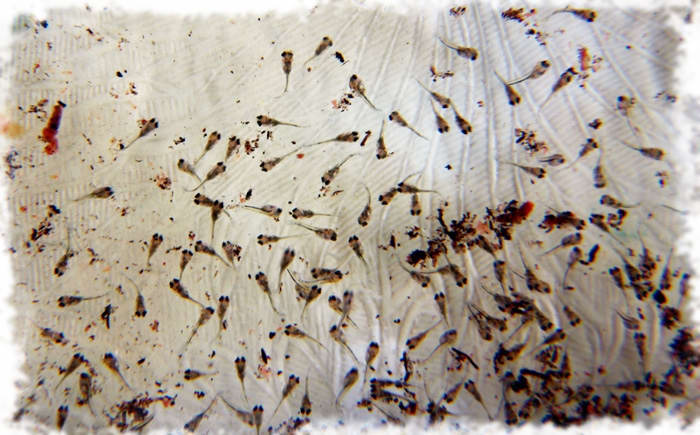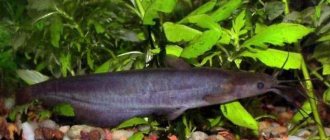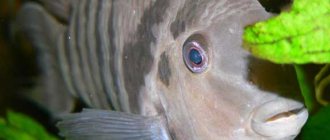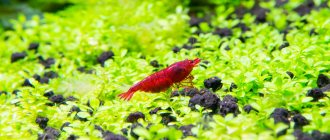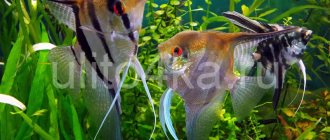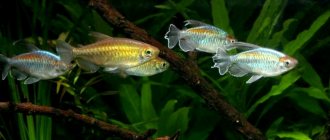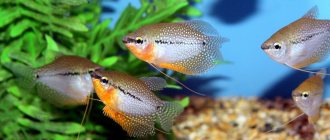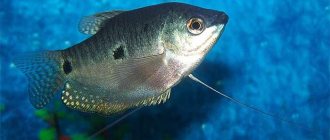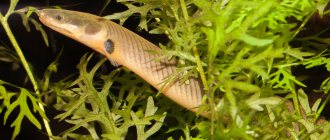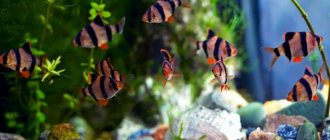In nature, there are many representatives of the Cichlid family. Almost the most popular among them is considered to be Cichlazoma meeka, a fish distinguished not only by its bright coloring, but also by its peaceful disposition and the absence of the need to carefully care for it. Beginning aquarists can also keep individuals representing this species. They can easily cope with the task of caring for them.
Description
For the first time, the cichlid meeka became known in 1918, thanks to the scientist Brind. The name was given to it in honor of the compiler of the world's first book about the fish of Mexico, namely Seth Eugene Meek. Distinctive external characteristics of individuals are:
- silver-violet body color, the presence of vertical spots of a dark shade;
- red tint to gills and throat;
- large sizes (10-17 cm in length);
- slender, laterally compressed body;
- pointed muzzle with sloping forehead;
- the presence of large fins with pointed ends.
Many people wonder how long the described representatives of cichlids live. With proper care and maintenance in captivity, they can survive for about ten years. The above is a general description of the fish, however, in their natural habitat, their color may vary somewhat due to the region and parameters of the water masses.
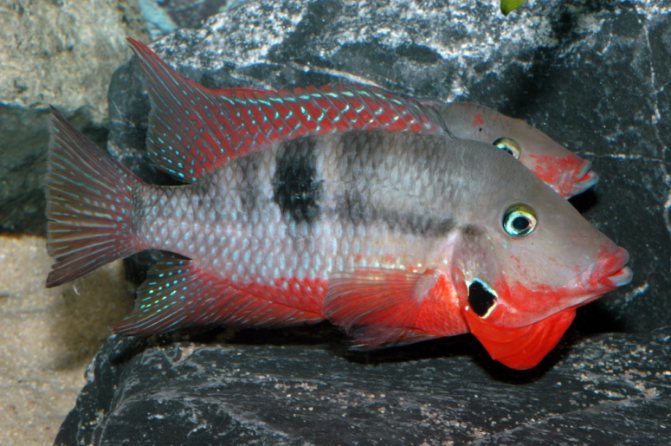
Habitat of Meeka cichlases
In nature, Cichlazoma Meeki inhabits the waters of Guatemala, Belize and Southern Mexico, from the Grijalva River to the north of the Yucatan Peninsula. It is found in biotopes with different conditions, which largely determines the many color variations of this species. The most striking specimens live near the town of Villa Hermosa, located in the Mexican state of Tabasco. Local reservoirs are a chain of small spring lakes (lagoons) with warm water and a muddy bottom. Since the water in these lakes is stagnant, it is heated by the sun to a temperature of 28-32 ° C and remains so even with the onset of the rainy season (which in these parts occurs in May-October). As a rule, the surface of these reservoirs is covered with floating plants. The population density of lakes with fish is quite high. The local Meeka cichlasomas have a short but tall body; they rarely grow more than 10 cm in length, which is compensated by their very bright coloring, especially on the belly and gill covers.
The cichlases that inhabit the Mexican rivers flowing through the territories of the states of Tabasco and Campeche have a longer body with shiny blue spots scattered across the surface. But the coloring of the lower part of the body is not as intense as that of lake capes. The average annual water temperature in these places is in the range of 25-28°C. The river bottom is mostly sandy, covered with fallen leaves and drowned tree trunks. The species composition of fish here is the same as in the lagoons, but the population density is lower.
The next biotope is natural wells (“cenotes”) and brackish lagoons located on the western and northwestern coast of the Yucatan Peninsula. It is a limestone platform, and since limestone is a soft material, over time the water has eroded many underground gullies in it, which are large voids and channels, in place of which karst sinkholes filled with cool, muddy water have formed. The depth of such reservoirs reaches 15 meters. The local cichlazomas Meeka live at shallow depths, where the water warms up to 20-25°C. The water in brackish lagoons is even warmer. These reservoirs are almost completely devoid of aquatic vegetation. Meek's cichlazomas living here are noticeably larger, but less brightly colored. As for the chemical composition of water in the habitats of this species, they are as follows: hardness from 20°dGH or more, and pH lies in the range from 7.5 to 8.5.
Habitat in nature
The habitat of fish in nature is not limited to one place. This is almost the entire territory of Central America, namely the rivers of such countries as:
- Mexico;
- Guatemala;
- Salvador;
- Costa Rica;
- Honduras;
- Panama.
In addition, many ichthyologists noted that they had encountered fish in reservoirs flowing in Singapore and Colombia. In the natural environment, there are not many representatives of the described species of the Cichlid family, since they are mainly bred by breeders in aquariums. In the natural environment, fish usually occupy the lower and middle layers of water masses. They live in both fresh and salty waters. Individuals prefer places where the bottom is muddy or sandy. They usually stay together near areas overgrown with river plants.
Conditions for keeping Meeka in the aquarium
Type: chordates.
Class: ray-finned.
Order: Perciformes.
Family: Cichlids.
Genus: cichlazomas.
Latin name: Thorichthys meeki.
The fish needs warm water - 25-27 degrees, pH 7.0-8.2; dGH 8-16. as well as a spacious aquarium. A pair of Meeka cichlases is kept in a tank with a volume of 60-70 liters. Lighting can be anything. Place soft soil at least 7 cm thick on the bottom of the aquarium, such as fine gravel, quartz or granite. The fact is that the inhabitants of the aquarium will dig into it and tear out plants. To avoid having to replant crops every day, choose plants with strong roots or plant them in special pots. Croptocorynes, Echinodorus, and Anubias are suitable plants.
For a comfortable existence, fish need shelter. These can be driftwood, various stones, grottoes. Be sure to install a compressor and a good filter in the container. Do not forget that pets may not survive a sharp jump in nitrates and nitrites. Replace 30% of the water with fresh water weekly and siphon the soil.
Fish, like other creatures, need adequate nutrition. Feed them with ready-made dry food intended for cichlids and live food.
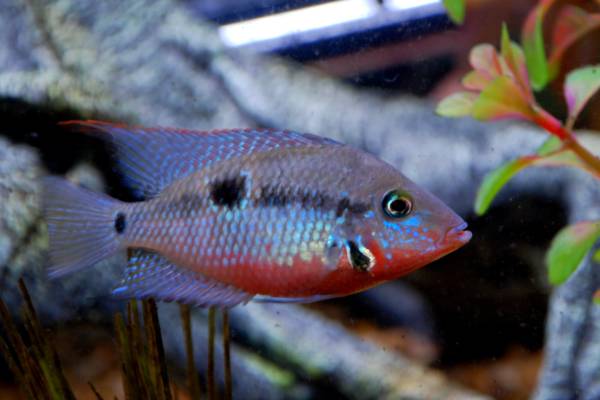
Maintenance and care
When setting up an aquarium, it is important to observe the basic parameters:
- aquarium volume – at least 200 liters;
- temperature of water masses – 20-26°С;
- acidity (pH) – 7°;
- hardness (dH) – 8-10°;
- the substrate is sandy.
Container lighting should be moderate. Considering the fact that fish need clean air for normal life, it is imperative to install water filtration and aeration systems, heating if necessary.
Considering that keeping an aquarium fish does not require special attention from the breeder, it is enough to replace 15-20% of the water mass from the container once a week. To decorate it, you can use living plants that have a strong root system. It is important that the fish have a place to hide, and therefore the installation of castles, sunken ships and other decorative elements is encouraged.
Habitat
Distributed on the Yucatan Peninsula in the territory of modern Mexico and Guatemala. Inhabits lowland rivers with moderate currents, prefers shallow water up to 1.5 meters deep. It successfully tolerates turbidity and brackishness of water, so it can swim into river deltas, small lagoons formed at the boundary of mixing fresh and salt water from the Atlantic. Requirements and conditions:
- Aquarium volume - from 200 liters.
- Temperature - 20–26°C
- pH value - about 7.0
- Water hardness - soft (8-10dH)
- Substrate type - sand
- Lighting - moderate
- Brackish water - 1-2 teaspoons per 10 liters of water is acceptable
- Water movement - moderate
Fish parameters:
- Size - 10–12 cm.
- Food - any
Feeding
The presented species of cichlids is omnivorous. It is important to use a variety of foods. They should be based on:
- artificial, frozen, live mixtures;
- small live fish, insects and their larvae;
- food of plant origin.
Experienced breeders recommend giving Cichlazoma meeca mixtures rich in protein. But you should not get carried away with bloodworms, since this food can cause fish to develop various diseases that disrupt the functioning of the gastrointestinal tract. One or two feedings per day are enough for them.
Cichlazoma Meeka - sexual dimorphism
Females are smaller than males, who have a tall, “iron-shaped” body and brighter coloring. Thread-like outgrowths at the ends of unpaired fins are present in representatives of both sexes, and in males they are more elongated. This difference is clearly visible when the fish fully extends its fins. Adult males of Meek's cichlazoma have a clearly visible pointed genital papilla. Thanks to this, determining the sex of fish is not a difficult task. Since the fry grow quite evenly, the sex of three-month-old and older fry can be easily determined by size. Males are already noticeably larger than females at this age.
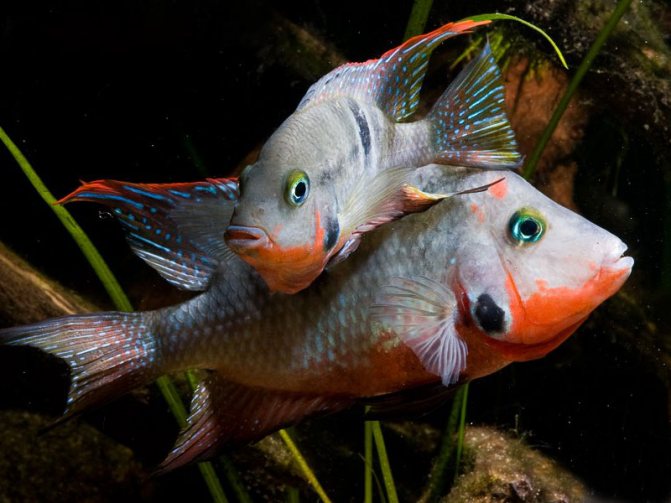
Cichlazoma Meeka, male and female
Reproduction and breeding
At home and in natural conditions, fish reproduction is different. The only similarity is the fact that they are monogamous creatures, which means that the males choose a female and stay with her for the rest of their lives.
In natural conditions
During spawning under natural conditions, the male builds a nest where the female lays eggs. They are then fertilized, after which the fry emerge within the first week.
At home
Breeding cichlids at home is not an easy task, but it is not that difficult either. In order to prevent fish from fighting during spawning, it is enough to move them into a separate tank. If this is not possible, then you will have to put up with the current circumstances.
It is important to place a smooth stone in the tank, which the female will clean before she lays her eggs there. The male fertilizes them, and a week later the fry appear. While they are growing up, they are always close to their parents who take care of them. With proper care and maintenance, one mature pair of cichlids can reproduce several times a year.
Reproduction
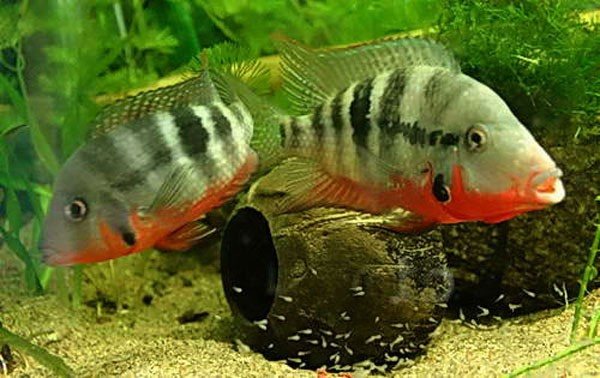
Meek's cichlids can reproduce in a community aquarium without any problems. With proper care, they can be bred even in a small aquarium.
In order to obtain offspring of Meek's cichlazoma, it is necessary to purchase an already formed pair in advance. Or purchase a small flock of young animals; over time, they will form pairs on their own.
As soon as it becomes clear that your pets are about to spawn, it is recommended to move their neighbors away to prevent attacks from future parents. It is not advisable to transplant the cichlids themselves, since such actions can provoke stress and, as a result, the cancellation of mating games.
To further stimulate spawning, it is necessary to increase the water temperature by several degrees, but on the contrary, reduce the hardness. The softer the water, the greater the chances of getting offspring, since eggs develop much worse in hard water.
The initial stage of spawning is the preparation by the male of a place for eggs. Most often they look for a wide, flat stone (it is recommended to arrange it in advance), which is thoroughly cleaned. As soon as the place is ready, the female lays eggs on it, which are immediately fertilized by the male.
After this, throughout the entire period of ripening of the eggs, the parents will diligently look after them, eating unfertilized eggs and giving maximum access to oxygen to the ripening ones.
From the moment the eggs are laid until the fry can swim independently, it takes from 5 to 7 days. As soon as the first attempts of the juveniles to swim are noted, they need to be fed. For this, plankton and artemia nauplii are used, and as they grow, cyclops and crushed tubifex are added. It is also allowed to use special food for fry of industrial origin.
Puberty occurs at 8, less often at 12 months.
Diseases and their prevention
Cichlids are fairly strong fish, and therefore are practically not susceptible to disease. The only thing is that if they are overfed, they may develop obesity, which will cause death. The best prevention for the development of diseases in cichlids is proper care.
Cichlazoma meeca is an ideal option for keeping at home. It does not require special attention from the aquarist, is unpretentious in food and generally has a peaceful disposition. In order for the fish to live for a long time, it is important to create optimal conditions for it.
Description of aquarium fish
It is unpretentious to living conditions. But it should be borne in mind that despite its peaceful nature, the fish is territorial. Mature males are very aggressive. If they don't like something, they will attack and fight.
Males grow up to 15-16 cm, and females are slightly smaller, up to 12 cm. They can be distinguished from each other by their fins. In “boy” fish, the anal and dorsal fins are pointed, and their tips are elongated into braids. Pay attention to the male's head. It is red underneath.
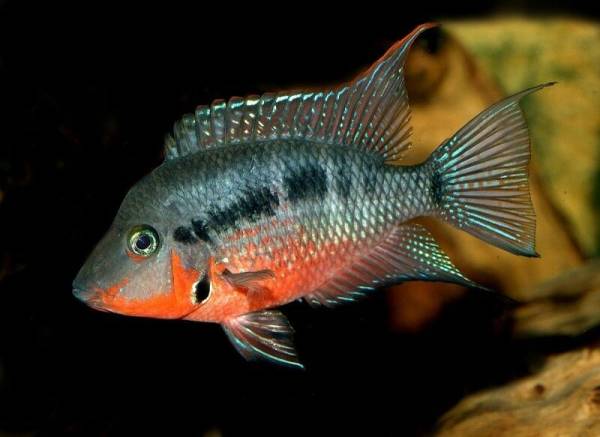
Photo of fish
in the photo there are juveniles - fry of the black-striped cichlazoma
After about three weeks, the juveniles can be transplanted into a nursery aquarium, observing the conditions described above and gradually transferring them to adult food and keeping conditions.
There are also other ways of breeding black-striped cichlases. For example, here is a method for those who do not want to bother with a spawning aquarium, but are afraid of aggressive behavior of fish or want to get more offspring than in a general aquarium. To do this, a partition is made across the width of the aquarium, for example, from plexiglass, which is installed in a common aquarium, separating the breeders from other fish.
To achieve better results, some aquarists immediately after spawning transfer the eggs with substrate to a fish tank with a low water level of 8-16 cm. Water is taken from the spawning aquarium. In this case, a so-called aeration point is established in the sedimentation tank, and a weak dose of methylene blue is added to the water. In this case, all care for the offspring falls on the shoulders of the aquarist.
Interesting: There is an albino form of black-striped cichlasoma! It is not a separate species, but is the result of a rare genetic abnormality. Albinism manifests itself in the offspring of any species of living beings. "Black-striped albino" lives both in the natural range of fish and in aquariums. The conditions for keeping and breeding this form are similar to those described above. However, the albino form has weaker immunity and is more susceptible to disease.
Oh, and there is also Cichlasoma nigrofasciatum var. Flamingo is a breeding form of black-striped cichlazoma - “Flamingo”.
Spawning of black-striped cichlazoma
It can occur year-round with short breaks, both in a general aquarium and in a separate spawning reservoir. To achieve better results, it is still recommended to plant more productively in the spawning tank, thereby reducing the stress factor, territorial troubles with other fish, and in addition, with this method, more offspring are preserved.
The parameters of aquarium water for spawning do not play a special role. As a stimulus for spawning, 1/4 - 1/5 of the aquarium water is replaced and the temperature is increased by a couple of degrees (about 28-29 ° C).
After a short period of courtship, the female lays eggs in a place of her choice; it can be a stone, the bottom of a pot, a shell, another shelter, even a coconut shell is suitable for these purposes. Sometimes eggs are deposited on a plant leaf. After spawning, the parents show excessive aggression towards all “uninvited guests” who swim into their territory. Even if it is a large fish, the parents will fight to the last for the eggs and fry.
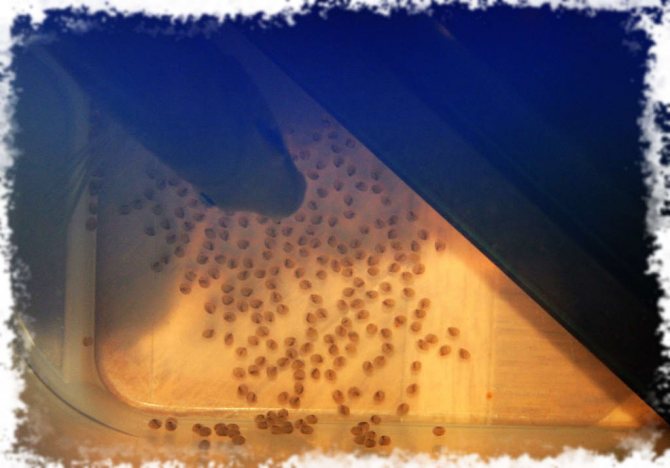
Fish care rules
Cichlazoma Meeka is a fairly simple fish to keep; even a novice aquarist can handle it without any problems. Representatives of this species adapt well to new conditions and are considered unpretentious fish. In their natural environment, they live in water of different composition and temperature, so they have learned to adapt well. But this does not mean that you don’t need to take care of them.
As for food, such pets are picky and omnivorous. They can eat any food:
- alive;
- artificial;
- frozen.
But in order for the fish to be healthy, it should be provided with a varied diet. The main food can be special food for cichlids, which contains everything you need. In addition, cichlid needs to be fed with frozen food . Bloodworms should be given to her in moderation, otherwise she may have problems with the gastrointestinal tract.
Diseases
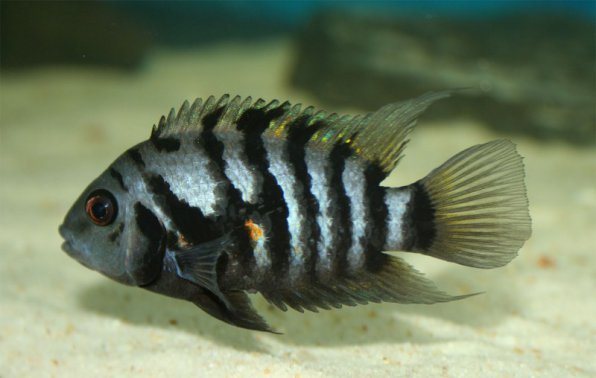
Cichlazoma Meeka is distinguished by good health, but improper care and living conditions lead to diseases even of such hardy creatures.
- Mechanical damage. Meeks are active pets and damage to their skin and fins is common. Most often, wounds heal on their own, but if the damage is serious, then remove the sick fish and add disinfectants to the water, for example, antibiotics, a solution of table salt or furacillin.
- Nitrate poisoning. When the water contains nitrates, the pet becomes lethargic, timid, photophobic, its gills become darker in color, and the cichlisoma itself swims poorly. For treatment, replace some of the water with fresh water and install a filter.
- Fin rot. If improperly cared for, cichlids will develop a light stripe of rot on their fins, which without treatment will spread to all fins. Fin rot is treated with antibiotics and proper maintenance.
In general, meek cichlazomas are tenacious, but poor or improper care can cause ailments such as fin rot, fungus, or parasite infestation. It is necessary to monitor the fish and, if suspicious spots, stripes or plaque are found on the body, place sick individuals in quarantine. Infections are treated with antibiotics or salt baths. The fish are immersed in the prepared solution for several hours. If the disease is not advanced, treatment is most often successful.
Fish should not be overfed, and in case of overfeeding, it is necessary to arrange a fasting day - leave the “glutton” for a day without food. It is necessary to carefully monitor the cleanliness of the aquarium, thin out the plants and monitor water levels. Cichlazoma meeka, living in comfortable conditions, will delight its owner with its bright iridescent color and active behavior.
In the next video you can watch meek feeding with cichlases.
in the photo cichlazoma black-striped caviar
During the incubation period, producers carefully care for the eggs, ensure cleanliness, and remove unfertilized and dead eggs.
After the larvae appear, the parents (female) move them to another secluded place, usually a corner of the aquarium with suitable shelter. After two to three days (when the yolk sac of the larvae disappears), the larvae emerge from the shelter and begin to swim under the close attention of their parents. To feed the young, the female, waving her fins, removes the turbidity from the bottom of the aquarium, and in the evening gathers everyone back into the shelter.
